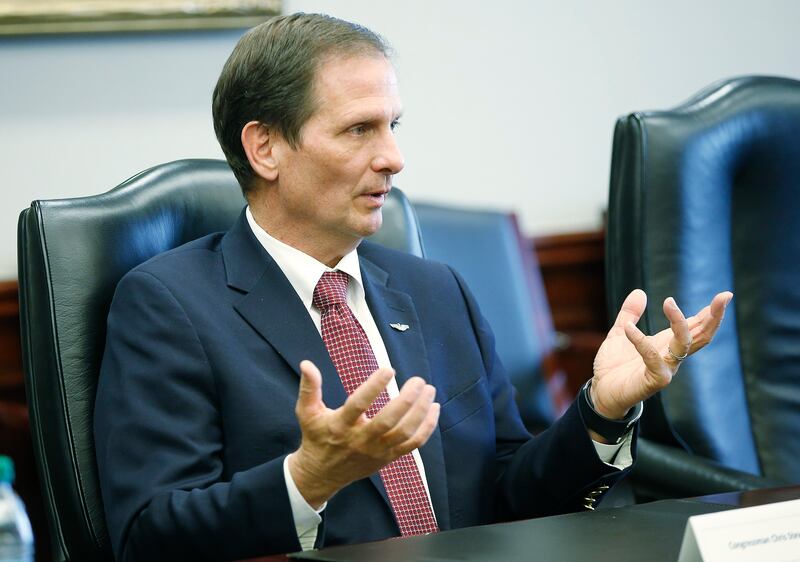SALT LAKE CITY — Antibody testing, antiviral drugs and vaccines are among developments that could help shape strategies to get the U.S. economy moving again, Utah Rep. Chris Stewart said Monday.
Though antibody testing might be a key part of any plan, it’s more complicated than that, he said, noting that hundreds of millions of people would need to be tested for COVID-19. In addition, a vaccine is at least 14 months or more away, Stewart said.
And as Anthony Fauci — the nation’s top infectious disease expert — noted, reopening the country isn’t like flipping a light switch, Stewart said on KSL Newsradio’s “Dave and Dujanovic.” Testing must continue and health care capacity in some area needs to be built up.
“But we do have to talk about getting people back to work,” Stewart said. “You can’t imagine the people I’ve talked to the past three weeks whose lives have been economically destroyed by this. They didn’t see it coming. None of us did. They honestly don’t know what their future looks like.”
President Donald Trump is aiming for May 1 to get businesses up and running. He said he didn’t want to say that at a press briefing in Washington, D.C., on Monday, but said certain states are doing well and the administration would set out guidelines for reopening in the coming days.
More than 16 million Americans have filed unemployment claims, including more than 82,000 in Utah, in the past three weeks.
Utah state epidemiologist Dr. Angela Dunn said antibody tests are still under development at national laboratories, including the Centers for Disease Control and Prevention and ARUP in Utah. The test uses blood to find out whether a person has been exposed to COVID-19 in the past.
“There’s still some investigation work that needs to be done to determine the usefulness of those tests. They depend on a high prevalence of disease or having a lot of the population being infected with the disease already before we can trust those results,” she said Monday at a press briefing.
Asked if people who are asymptomatic or healthy but don’t have the antibodies should be able to risk going back out, Stewart said that’s the question policymakers have. In the long term, not just over the next month, people will do what’s necessary to protect their families, community and nation, he said.
“But we can’t be in a situation where every six months we shut down the entire economy. That’s beyond devastating for people. It’s absolutely incomprehensible the damage that would do to people’s lives if every six months we go through this. Frankly, we couldn’t possibly afford it,” he said.

Stewart said the country could run a $4 trillion to $5 trillion deficit this year alone because of the crisis. He favors allocating another $250 billion to help small businesses, a proposal Democratic lawmaker blocked last week while seeking to add more money for hospitals and local government.
The $2.2 trillion Coronavirus Aid, Relief and Economic Security Act saved 15 million jobs, Stewart said.
Sen. Mitt Romney, R-Utah, said in a tweet Monday that there is a difference between a relief package and a stimulus package.
“Attention media and pundits: CARES Act is a rescue/relief package, not a “stimulus.” It’s an emergency measure to help people in need, keep people in jobs, boost unemployment checks, save hospitals, shore up states. A shuttered economy can’t be “stimulated”— that will come later,” he said.
Utah Gov. Gary Herbert extended his “stay home, stay safe” directive through May 1.
The governor’s office is trying to determine specific measures the state can track to “understand when we should be able to open up the economy more, but also safely,” Dunn said.
Those things include seeing a steady decline in the rate of new COVID-19 cases and maintaining the capacity to test anyone who needs it as well as contact tracing and quarantining people, she said,
“All of those factors will be considered when we’re looking at policies to reopen pieces of our economy,” Dunn said.
Dunn said growth rate of cases in Utah has declined over the past several days.
“With this outbreak, we are looking at a two-week trend in order to start making any assumptions because the incubation period is two weeks,” she said, adding that more people still need to be tested to understand how widespread the disease is.
As for the “soft opening idea on May 1,” Dunn said the state is going to let data drive its decisions both for the economy and people’s health.
Val Hale, executive director of the Governor’s Office of Economic Development, said given the hopeful signs in some of the trends, his office is starting to talk about moving from an urgency phase to a stability phase as part of the state’s three-phase economic response plan.


